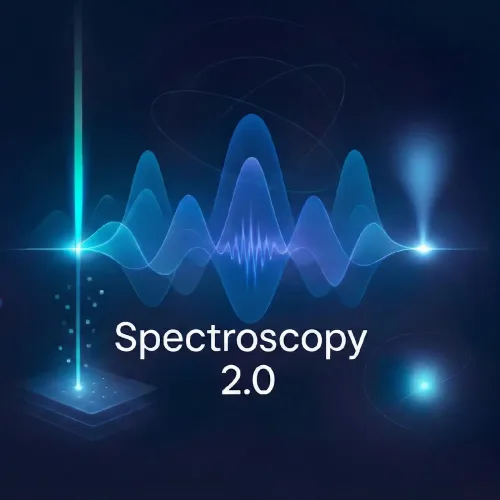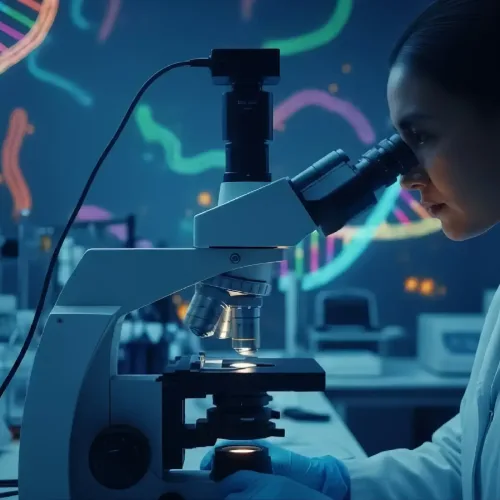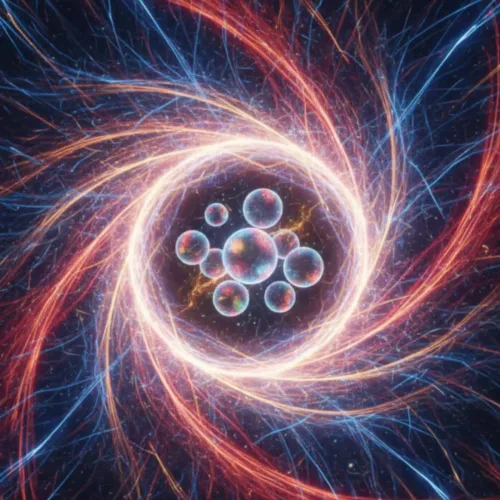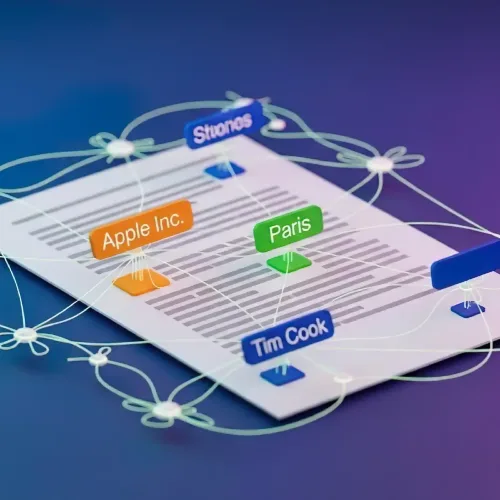A sea turtle swims in the water to eat its favorite food, jellyfish. Little does it know that what it thinks is a jellyfish is not a fish, but a plastic bag. It eats it, which causes many diseases inside it. This is just one example, pointing to a serious problem. It is estimated that more than eight million tons of plastic enter our oceans every year, causing many environmental problems. From the vast garbage patches of the Pacific Ocean to the deep ocean depths of the Indian Ocean, there is garbage everywhere. These piles of plastic are harmful to marine animals. They also endanger the lives of all those humans who depend on these oceans in one way or another. In this post, you will learn how plastic pollution affects marine life, from whales to coral reefs. We will explore emerging threats like ingestion, entanglement, habitat destruction, and plasticosis. You will also discover practical steps to reduce your plastic footprint — both at home and in your community.
At Learning Breeze, we’re dedicated to raising environmental awareness by breaking down complex issues into clear, actionable insights. Let’s dive deeper into understanding this crisis and discover how each of us can contribute to preserving the incredible biodiversity of our ocean.
The Silent Scourge: How Plastic Pollution Affects Marine Life
Plastic pollution harms marine life in various ways. Marine animals either eat them or get entangled in them, which creates serious problems for them. Some of these problems are described here. Let’s see.
1. Ingestion: A Deadly Mistake
Many marine animals mistake plastic for food. For example, loggerhead sea turtles eat plastic bags thinking that it is their favorite dish, jellyfish. The plastic gets stuck inside them, causing various diseases and eventually ending their lives. A 2015 study showed that about 90 percent of seabirds have ingested this plastic. Experts expect that all seabirds will ingest this plastic by about 2050.
Microplastics are a type of plastic that is smaller than five millimeters in size and are produced from various types of plastic bottles, cosmetics, and synthetic fabrics. Small marine animals such as plankton eat these microplastics and then when larger animals such as whales or dolphins eat them, problems arise within them as well. Microplastics also release harmful chemical BPA into the water, which can disrupt hormones and cause health problems in marine animals.
2. Entanglement: Trapped by Our Waste
Marine animals face another problem. They get trapped in piles of plastic in the ocean. This happens when fishing nets break and are left in the ocean. It also includes plastic bags, garbage bags, etc. When marine creatures get stuck in them, it also causes serious problems for them. For example, seals caught in nets can be badly injured, reducing their chances of survival.
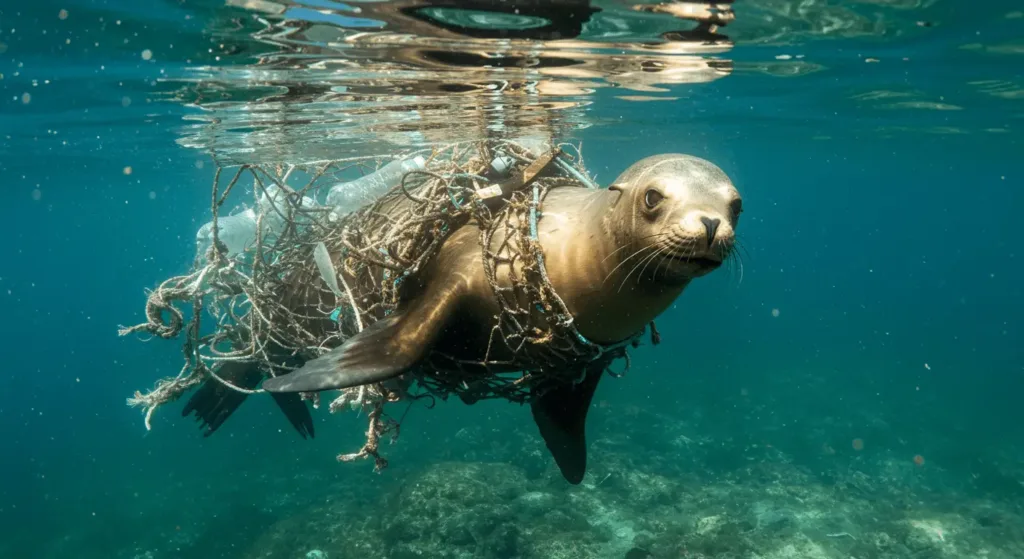
3. Habitat Destruction & Alteration
This pile of plastic waste on the ocean floor covers the coral reefs at the bottom of the ocean and also settles on the bottom of the ocean, preventing sunlight from reaching them. This impacts their growth and affects the entire food chain. In the Pacific Ocean, large piles of plastic form “rafts” that act as fake homes, allowing harmful species to travel and potentially engulfing local marine life.
Global Sources of Ocean Plastic
| Source Type | Top Contributor | Example |
|---|---|---|
| Single-Use Plastics | Shopping bags, bottles | 50% of waste |
| Industrial Runoff | Microbeads | Personal care |
| Agricultural Runoff | Pesticide coatings | Crop fields |
| Poor Waste Management | Open dumps | Coastal regions |
What YOU Can Do to Be Part of the Solution
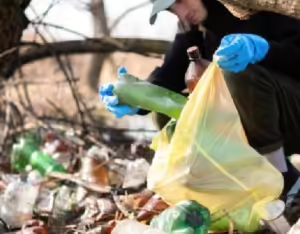
Even though plastic pollution seems like a huge problem, small individual actions can make a big difference. There are a few simple steps you can take:
A. At Home & In Your Daily Life
Reduce
- Refuse single-use plastics: use reusable bags, bottles, and coffee cups.
- Choose minimal packaging: buy loose produce and in bulk.
Reuse
- Repurpose containers for storage.
- Mend plastic items instead of discarding them.
Recycle (Responsibly)
- Learn local recycling guidelines.
- Clean and sort plastics to avoid contamination.
Avoid Microbeads
- Check labels for polyethylene, polypropylene, or microbeads.
- Switch to natural alternatives like oatmeal scrubs.
Table comparing single-use plastics with reusable alternatives
| Item | Single-Use Plastic | Reusable Alternative | Environmental Benefit |
|---|---|---|---|
| Shopping Bag | Plastic Bag | Cloth or Canvas Bag | Reduces landfill waste |
| Water Bottle | Plastic Bottle | Stainless Steel Bottle | Prevents ocean pollution |
| Coffee Cup | Disposable Cup | Reusable Travel Mug | Saves resources |
| Utensils | Plastic Cutlery | Bamboo or Metal Utensils | Reduces microplastic risk |
B. Beyond Individual Action (Community & Advocacy)
- Participate in Cleanups
- Join beach or river cleanups.
- Organize local events with schools or civic groups.
- Support Eco-Friendly Businesses
- Buy products from brands that use recycled or compostable materials.
- Share your experience on social media to boost ethical companies.
- Advocate for Policy Change
- Contact local representatives to support plastic bans or taxes.
- Sign petitions calling for better waste management.
- Educate Others
- Talk with friends and family about plastic pollution.
- Use resources from Learning Breeze Earth to teach kids.
C. The Power of Choice
Every choice you make matters. Using a reusable straw once may seem small, but if many people do it, the impact increases. You are part of a larger group who want cleaner oceans.
Protection of Marine Life
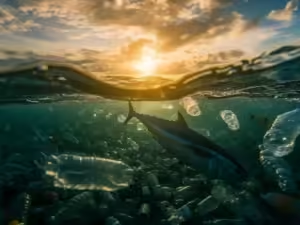
Oceans play a vital role in maintaining our climate, providing the food and supporting life on Earth. But plastic pollution is putting all of these ecosystems at risk. Sea turtles, dolphins, fishes, and other marine creatures are suffering as the amount of plastic in their environment increases. From eating plastic to getting trapped in debris, they face serious challenges.
By making small changes in our daily lives, we can reduce plastic waste and prevent further harm to our environment. Reusing products, recycling properly and supporting clean-up efforts may look like small actions, but together they make a big difference. Marine life does not have a voice, but we do. We must step up and help to protect these animals from the dangers of plastic pollution.
A Glimmer of Hope: Innovations and Progress
A. Technological Solutions
Projects like The Ocean Cleanup use floating barriers to collect plastic. New recycling plants can now turn mixed plastics into fuel or new items. Scientists are also looking for microbes that can help break down these plastics underwater.
B. Policy & Legislation
More than 60 countries have banned the use of plastic bags. According to the UN, plastic use is expected to be reduced by 90 percent by 2029, but this is just an estimate; only time will tell how much action is taken.
C. The Growing Awareness
Social media campaigns like #BeatPlasticPollution have reached millions. Documentaries and school programs promote ocean literacy in the next generation.
Conclusion
Plastic pollution is one of the most significant environmental issues today, and its impact on marine life is life-threatening. Every piece of plastic floating in the ocean contributes to the destruction of so many marine creatures. But we can change the situation. By reducing plastic use, joining initiatives to remove plastic, and pushing for better waste management, we can protect marine animals from this growing threat.
So, are you ready to take action? Will you reduce plastic use or join a clean-up effort? The future of our oceans depends on the steps we take today. Let’s work together to protect marine life and restore the beauty of our oceans.
References
- Wilcox, C., et al. (2015). Plastic waste inputs from land into the ocean. Science, 347(6223), 768-771
- The Ocean Cleanup
- European Union Directive on Single-Use Plastics
- Ocean Conservancy
- Surfrider Foundation

